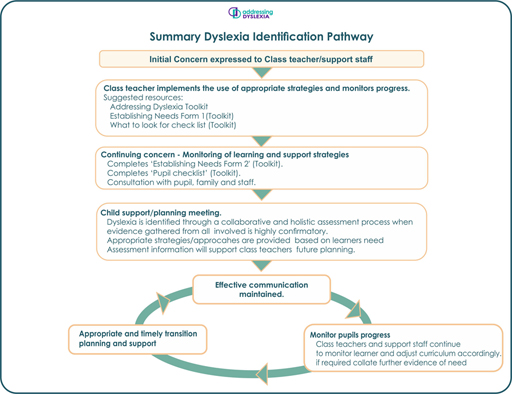The Process of Identification.
Recap
The Addressing Dyslexia Toolkit and Modules 1 and 2 provide information on the identification pathway for dyslexia and literacy difficulties. This section aims to explore this in further detail.
Module 2 section 2.3 explained that everyone has the skills and abilities to recognise early signs of dyslexia in children at all stages, and to take appropriate action in response. Pupil support begins with the class teachers; however this does notmean that class teachers are responsible for the formal identification of dyslexia. It means they play an important role in the initial stages and the continuing monitoring and assessment of learning – as they do for all their pupils.
The Toolkit and the modules highlighted
- The rationale of a dynamic and holistic assessment
- The roles of those involved in the process
- That parents, carers and children over 12 years old have the legal right to request an assessment and this should be started within 6 weeks of the request.
Figure 10 provides an overview of the identification pathway.
You should be familiar with the Scottish working definition of dyslexia. However to help work through this section the following files aim to provide some support and are available on the Toolkit.
Click the ‘link’ to the Scottish Working Definition - http://addressingdyslexia.org/ what-dyslexia [Tip: hold Ctrl and click a link to open it in a new tab. (Hide tip)]
Download a copy of the Scottish Working Definition and Planning Tool
Click the ‘link’ to access an expanded version of the identification pathway - http://addressingdyslexia.org/ assessing-and-monitoring
- Starting the Process
- What to look for
- Other factors
Identification and timescales

